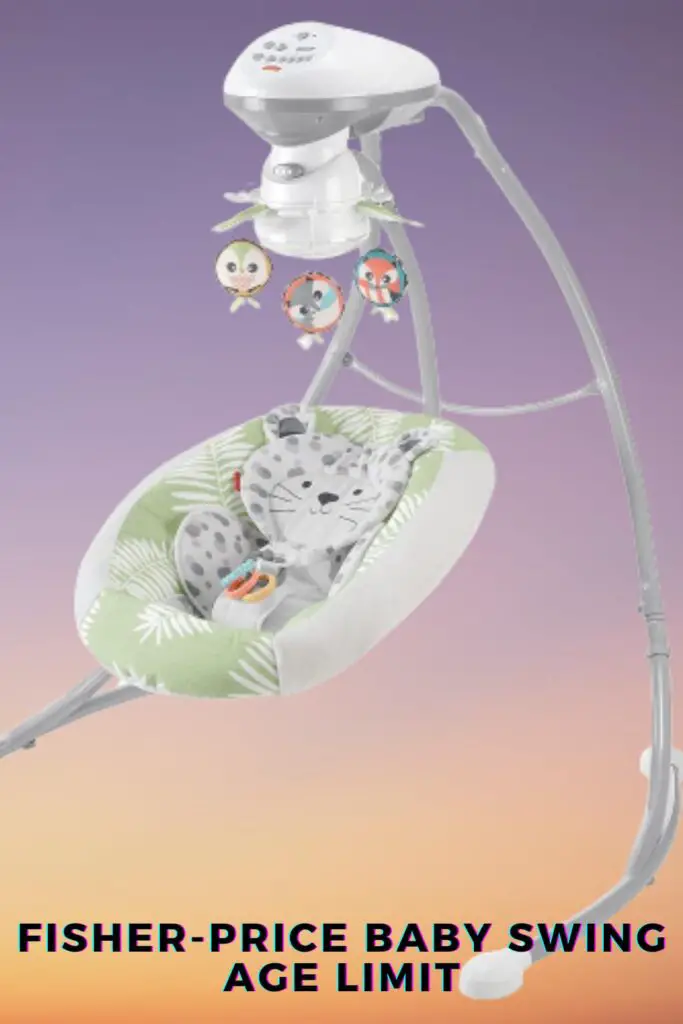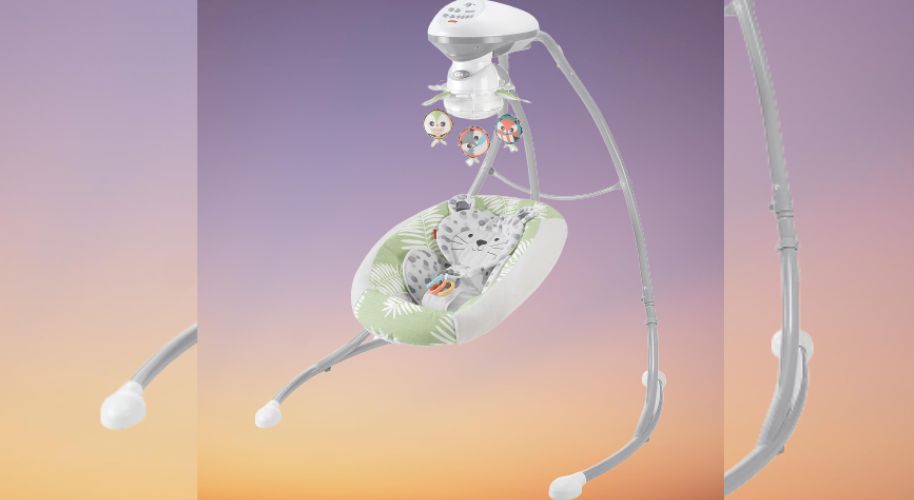Last Updated on June 5, 2025
Fisher-Price is one of the top manufacturers when it comes to baby swings. Baby swings are great for helping your little one relax and giving parents a break!
But an important safety consideration that goes along with using a Fisher-Price baby swing is the age limit. It’s critical to ensure you’re following the age limits to ensure your baby is safe and secure while having fun in their swing.
In this article, we’ve put together this guide to help you understand Fisher-Price’s baby swing age limit and how best to use it for your little one.

Fisher-Price Baby Swing Age Limit
The answer could be more straightforward regarding the age limit for Fisher-Price baby swings. Generally speaking, most Fisher-Price swings are safe for use from birth. However, this can vary depending on the specific model and its weight capacity.
When To Start Using Fisher-Price Baby Swings
Fisher-Price baby swings are designed for babies from birth up to 25 pounds or 30 inches tall.
However, it’s important to note that the American Academy of Pediatrics recommends not using any infant seat or swing until your baby can hold their head up independently, usually between 4 and 6 months old.
When to stop using Fisher-Price baby swings
When using Fisher-Price baby swings, parents should be aware of when to stop using them. Generally speaking, babies will outgrow a swing when they are 9-10 months old.
However, some bouncers or baby swings designed to hold up to 30 pounds may be able to accommodate your child for longer. You should start weaning your infant out of the swing at around four months.
If you place your infant on a flat surface for napping or put them in a crib instead of the swing, they will become more comfortable with this transition.
You should also stop using a baby swing once your infant shows signs they want to crawl out (usually around 9 months).
Fisher-Price Baby Swings
Fisher-Price is a trusted brand that offers a variety of options for parents.
When your baby is ready for a swing, Fisher-Price has several options.
The Fisher-Price Sweet Snugapuppy Dreams Cradle ‘n Swing is designed to keep your little one entertained by two swinging motions, six speeds, and music and nature sounds. It has an adjustable recline position and a removable toy bar with two soft toys.
The Fisher-Price Deluxe Take Along Swing & Seat is another great option for parents on the go. This swing folds easily for storage or travel and features two recline positions, six swing speeds, 10 melodies, and five nature sounds.
It also has an overhead mobile with three soft toys to keep your baby entertained while they relax in the swing.
Is There a Weight Limit for Fisher-Price Baby Swings?
Are you wondering if there is a weight limit for Fisher-Price baby swings? The answer is yes. The weight limit for most Fisher-Price baby swings is 25 lbs.
The Fisher-Price Infant-to-Toddler Rocker has a maximum holding capacity of 40 lbs and can be used by children up to fifteen months old. However, this is an exception, as most other models have a weight limit of 25 lbs.
It’s important to check the weight limit before purchasing a baby swing to ensure it will be safe for your child.
How Long Can You Use A Fisher-Price Baby Swing Per Day?
How long can you use a Fisher-Price baby swing per day? It’s an important question to consider when deciding which baby swing is right for your family.
The answer depends on the age and weight of your baby, as well as the type of swing you choose. Generally speaking, it’s recommended that babies under four months old should not be in a swing for more than 30 minutes at a time.
For babies older than four months, keeping them in a swing for up to two hours per day is generally safe. However, following the manufacturer’s instructions and guidelines when using baby equipment is always best.
You Might also Like These Resources !
- Baby Swing Weight and Age Limits: What You Need to Know
- Playpen Age Range: When Is It Suitable? Baby’s Playpen Age Limits
Safety Tips for Using a Baby Swing

When it comes to baby swings, safety should be your top priority. Here are some tips for using a baby swing safely:
Check for recalls – Before using a baby swing, make sure it has not been recalled by searching the U.S. Consumer Product Safety Commission website.
Read the instruction manual – Ensure you understand the instructions before using a baby swing. This will help ensure that you use it correctly and safely.
Check the weight limits – Every baby swing has weight limits, so make sure your child does not exceed them when they are in the swing.
Steady placement – Place the swing on a flat, steady surface and make sure it is secure before putting your baby in it.
Reclined position – The American Academy of Pediatrics recommends that infants under 4 months old be placed in the most reclined position in their swing to avoid slumping over and suffocating.
Limit time spent in the swing – Babies should not spend too long in a swing as this can cause physical problems such as flat spots on their heads or blocked airways due to prolonged pressure on their necks and chests from being in one position for too long. We recommend limiting swinging time to no more than 30 minutes at a time, even if your baby seems contented with longer periods of swinging time.
Avoid elevated surfaces – Even smaller, portable swings should be placed on the floor and not on a table, counter, or other high surface to ensure the swing is stable and secure when your child is in it.
FAQS
Can Preemies Be Put in a Fisher-Price Baby Swing?
When it comes to putting preemies in a Fisher-Price baby swing, the answer is yes. Preemies can be put in a Fisher-Price baby swing as long as they can hold their heads up and have adequate neck strength.
It’s important to ensure that the swing is properly adjusted for your preemie’s size and weight and that you monitor them closely while in the swing.
What Is a Baby Swing?
A baby swing provides a gentle, rocking motion to soothe and entertain babies. Baby swings typically have adjustable speeds and may also include features such as vibration, music, lights, and toys.
Some models can be used both indoors and outdoors. Baby swings are available in sizes and styles, ranging from full-size stationary swings to more portable, lightweight models.
Is It Okay for My Baby to Sleep in a Swing?
Swings are designed to provide comfort and entertainment for your baby while you’re busy with other tasks. But they aren’t designed for sleeping, as infants haven’t developed their muscles enough to hold up their heads.
Babies can easily fall forward and become trapped against the straps or sides of the swing, leading to suffocation. Swings also don’t provide enough support for an infant’s head and neck, which can cause breathing difficulties.
Wrapping Up
A baby swing can be a great way to soothe and entertain your little one. But it’s important to ensure you use the swing safely and correctly by following the abovementioned tips.
Ensure you check the weight limits, place the swing on a flat, steady surface, keep babies in a reclined position, limit their time in the swing, and don’t use it for sleeping.
Doing so lets your baby be safe and comfortable while they enjoy their time in the swing.
Thank you for reading this article. We hope that you have found it helpful and that it has given you some useful tips for using your baby swing safely. Take care!
You Might Also Like These Latest Content !
- Finding Replacement Parts for Your Ingenuity Baby Swing
- Necessity of Having a Baby Swing
- Baby Swing Safety: Debunking Shaken Baby Syndrome Claims

Amy A. Vincent is a Certified Pediatric Sleep Consultant and a mother of three beautiful children. She helps parents transition their babies from swing sleep to safe, independent sleep. She is passionate about helping parents teach their children the skills needed to become good sleepers and aims to make the process as easy and stress-free as possible. Read more
